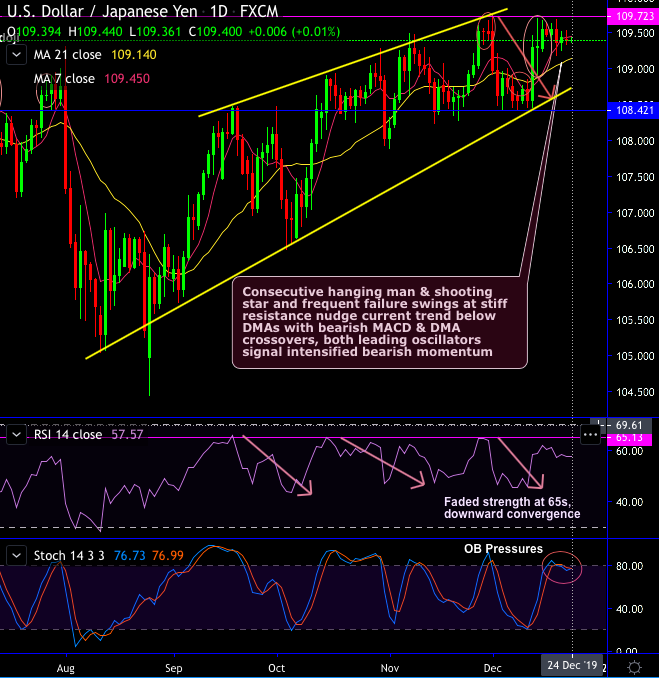USDJPY’s range in 2019 is likely to prove the tightest since the 1980s, a theme that should dominate next year’s outlook too. Indeed, assuming USDJPY remains within its 2019 range thus far (104.10-112.40), this year’s range will be just 7.6% from peak to trough, the tightest since 1980. Trading ranges of 10% or less have been historically somewhat rare over the past few decades, so to have three consecutive years with USDJPY in such a narrow range is all the more unusual; USDJPY has been confined to a rough 105-115 range for three years now. We see three factors behind this trend.
First, a declining Japan-US inflation differential suggests a fundamentally narrower path for USDJPY. Assuming the long-term level of exchange rates is influenced by inflation rate differentials, USDJPY’s tendency to trend toward Yen appreciation reflects the unsurprising fact that US inflation has on average been higher than that of Japan. However, this differential has narrowed substantially, from around 2.8%-pts on average from 2000 to 2012, to just 1.0%-pt. from 2013, the year that “Abenomics” began to dominate Japan’s macroeconomic narrative. This narrowing in the differential reflects an both increase in Japan’s average CPI rate over the same period (from -0.3%y/y to + 0.5%) as well as a decline in US inflation (+2.5%y/y to + 1.5%).
Second, the Yen is used less frequently as a short-term funding currency, implying lower potential for either sharp JPY weakness, or rapid JPY appreciation going forward. USD and JPY are both funding currencies in a broad sense: they are sold when investors become more risk-oriented, and bought back when sentiment deteriorates. In particular, since the mid-2000s, attention has been focused on Japan’s extremely low interest rates, incentivizing a higher degree of JPY sales during risk on episodes.
On the other hand, pressure to repurchase JPY when risk aversion became stronger had also increased. As a result, although USD and JPY tended to move in the same direction, when both weakened, JPY tended to weaken even more, and vice versa. This dynamic had previously widened USDJPY’s trading range, particularly during extreme swings in risk sentiment.
Technically, the minor trend of has been edging higher but oscillating within rising wedge pattern, currently, the upswings have been absolutely exhausted at the wedge resistance pattern (1st chart).
On a broader perspective, the major downtrend still remains intact on a bearish engulfing pattern with big real body (refer monthly plotting in 2nd chart), but the major trend is now stuck in the tight range, while the intermediate consolidation phase is capped at 100EMAs.
With leading oscillators entering in overbought zone and lagging indicators looking quite indecisive but bearish bias, contemplating both interim upswings and the major downtrend in the long term, prolonged range-bounded major trend remains intact.
Options Trades Tips:
Contemplating the major trend that has been range-bounded (oscillating between 114.731 and 104.464 levels), and low IVs (implied vols) environment, it is wise to deploy strangle short strategy. USDJPY displays the least IVs for 1m tenors among the G7 FX-bloc (refer 3rd chart) and the low vol regime is most likely to persist on the eve of festive season.
Hence, short (0.5%) out-of-the-money call and (0.5%) out-of-the-money put options of 1m tenor. The strategy can be executed at the net credit and certain yields would be derived in the form of initial premium received as long as the underlying spot FX remains between OTM strikes on the expiration. Courtesy: Tradingview, JPM & Saxobank



 Goldman Predicts 50% Odds of 10% U.S. Tariff on Copper by Q1 Close
Goldman Predicts 50% Odds of 10% U.S. Tariff on Copper by Q1 Close  FxWirePro: NZD/USD consolidates around 0 .5810,room for further gains
FxWirePro: NZD/USD consolidates around 0 .5810,room for further gains  Gold Prices Fall Amid Rate Jitters; Copper Steady as China Stimulus Eyed
Gold Prices Fall Amid Rate Jitters; Copper Steady as China Stimulus Eyed  FxWirePro: USD/ZAR neutral in the near-term, scope for downward resumption
FxWirePro: USD/ZAR neutral in the near-term, scope for downward resumption  UK GDP Flops Again: GBPJPY Drops to 207.22 But Bulls Hold the Line – Buy the Dip to 210?
UK GDP Flops Again: GBPJPY Drops to 207.22 But Bulls Hold the Line – Buy the Dip to 210?  FxWirePro- Major Crypto levels and bias summary
FxWirePro- Major Crypto levels and bias summary  FxWirePro- Woodies Pivot(Major)
FxWirePro- Woodies Pivot(Major)  U.S. Treasury Yields Expected to Decline Amid Cooling Economic Pressures
U.S. Treasury Yields Expected to Decline Amid Cooling Economic Pressures  FxWirePro: USD/CAD recovers slightly but trend is still bearish
FxWirePro: USD/CAD recovers slightly but trend is still bearish  FxWirePro: EUR/AUD trends higher, but faces potential pitfalls
FxWirePro: EUR/AUD trends higher, but faces potential pitfalls  Bitcoin Yawns at Fed Cut – Coiled Tight at $92K: $90K Hold = Straight Shot to $100K
Bitcoin Yawns at Fed Cut – Coiled Tight at $92K: $90K Hold = Straight Shot to $100K  Mexico's Undervalued Equity Market Offers Long-Term Investment Potential
Mexico's Undervalued Equity Market Offers Long-Term Investment Potential  FxWirePro: EUR/AUD moves higher following downbeat Australian jobs report
FxWirePro: EUR/AUD moves higher following downbeat Australian jobs report  UBS Projects Mixed Market Outlook for 2025 Amid Trump Policy Uncertainty
UBS Projects Mixed Market Outlook for 2025 Amid Trump Policy Uncertainty  Stock Futures Dip as Investors Await Key Payrolls Data
Stock Futures Dip as Investors Await Key Payrolls Data  Indonesia Surprises Markets with Interest Rate Cut Amid Currency Pressure
Indonesia Surprises Markets with Interest Rate Cut Amid Currency Pressure  Geopolitical Shocks That Could Reshape Financial Markets in 2025
Geopolitical Shocks That Could Reshape Financial Markets in 2025 






























